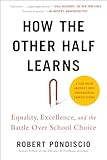How the other half learns : equality, excellence, and the battle over school choice / Robert Pondiscio.
Material type: TextLanguage: English Publisher: New York : Avery, 2020Description: viii, 374 pages, 23 cmContent type:
TextLanguage: English Publisher: New York : Avery, 2020Description: viii, 374 pages, 23 cmContent type: - text
- unmediated
- volume
- 9780525533757 (paperback)
- 0525533753 (paperback)
- Educational equalization -- United States
- Igualdad educativa -- Estados Unidos
- Charter schools -- United States
- School choice -- United States
- Elección de escuelas -- Estados Unidos
- Education and state -- United States
- Educación y Estado -- Estados Unidos
- Public schools -- Social aspects -- United States
- Escuelas públicas -- Aspectos sociales -- Estados Unidos
- 379.2/6
- LC 213.2 P796h 2020
| Item type | Current library | Home library | Collection | Shelving location | Call number | Copy number | Status | Barcode | |
|---|---|---|---|---|---|---|---|---|---|
 Libro
Libro
|
Biblioteca Juan Bosch | Biblioteca Juan Bosch | Humanidades | Humanidades (4to. Piso) | LC 213.2 P796h 2020 (Browse shelf(Opens below)) | 1 | Available | 00000163553 |
Cover--"A year inside America's most controversial charter school"
Includes bibliographical references and index.
The Tiffany test -- We have an army coming -- Bronx 1 -- No excuses -- Whack-a-mole -- I want to slit my wrists? -- Just let this Latina pass? -- Marriage counseling -- The window and the mirror -- Outliers -- The math lesson -- Catholic school on the outside, bank street on the inside -- Survival mode -- Releasing the beast -- Come to Jesus -- Plan of attack -- Teach me! -- Joy and vomit -- Testing day -- The lottery -- The gas factor -- Proof point -- Culture clash -- The likely list -- A place called school.
The promise of public education is excellence for all. But that promise has seldom been kept for low-income children of color in America. In "How the Other Half Learns", teacher and education writer Robert Pondiscio focuses on Success Academy, the network of controversial charter schools in New York City founded by Eva Moskowitz. Moskowitz has created something unprecedented in American education: a way for large numbers of engaged and ambitious low-income families of color to get an education for their children that equals and even exceeds what wealthy families take for granted. Her methods are unorthodox. Her results are astronishing. But are they replicable?-- Back cover
There are no comments on this title.

